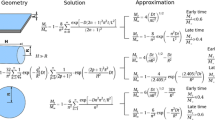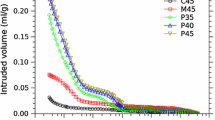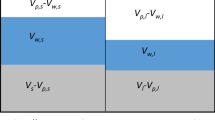Abstract
A finite element solution for a mass transport model for porous materials accounting for sorption hysteresis is presented in this paper. The model is prepared for modeling of concrete durability, but the general presentation makes it suitable for other porous materials like soil and tissues. The model is an extended version of the Poisson–Nernst–Planck (PNP) system of equations. The PNP extension includes a two-phase vapor and liquid model coupled by a sorption hysteresis function and a chemical equilibrium term. The strong and weak solutions for the equation system are shown, and a finite element formulation is established by Galerkin’s method. A single-parameter implicit time integration scheme is used for solving the transient response, and the out-of-balance solution is minimized by using a modified Newton–Raphson scheme in which the tangential stiffness is not computed exactly. The sorption hysteresis is added to the solution procedure by a rate function. The hysteresis effect is described by scanning curves defined between two boundary sorption isotherms. A numerical example was constructed to show the applicability and compare a simple approach and a extended approach within the sorption hysteresis model. The examples illustrate the impact of changing relative humidity at the mass transport boundary on the adsorption and desorption stages of a cement-based material. Changes in the pore solution ion concentrations are a result of the changing moisture content, which are shown by the example. Comparing the two approaches showed significant deviations in the liquid content and ion concentrations, in parts of the domain considered.






Similar content being viewed by others
Abbreviations
- \(c_{i}^{l}\) :
-
Ionic concentration of species \(i\) in liquid phase \(l\) (mol/l)
- \(\varepsilon ^{l}\) :
-
Liquid-phase volume fraction (\(\hbox {m}^{3}/\hbox {m}^{3}\))
- \(\varepsilon _{v}\) :
-
Vapor-phase volume fraction (\(\hbox {m}^{3}/\hbox {m}^{3}\))
- \(\rho _{i}^{l}\) :
-
Density of species \(i\) in the liquid phase \(l\) (\(\hbox {kg}/\hbox {m}^{3}\))
- \(D_{i}^{l}\) :
-
Diffusion coefficient for constituent \(i\) (\(\hbox {m}^{2}/\hbox {s}\))
- \(A_{i}^{l}\) :
-
Ion mobility (m\(^{2}\)/s V)
- \(z_{i}\) :
-
Valence (–)
- \(\Phi \) :
-
Electrical potential (V)
- \(q_{i}\) :
-
Chemical interactions (1/s)
- \(\xi _{d}\) :
-
Relative dielectricity coefficient (V/m)
- \(\xi _{0}\) :
-
Dielectricity coefficient of vacuum (V/m)
- \(F\) :
-
Faraday’s constant (C/mol)
- \(\rho _{w}\) :
-
Water density (kg/m\(^{3}\))
- \(D_{\varepsilon ^{l}}\) :
-
Diffusion coefficient for the liquid phase (m\(^{2}\)/s)
- \(\hat{m}_{l}\) :
-
Mass exchange of liquid phase
- \(\mathbf{v}^{l,s}\) :
-
Liquid-phase \(l\) velocity with respect to the solid \(s\) (m/s)
- \(\hat{m}_{l}\) :
-
Mass exchange of liquid phase
- \(\rho _{vs}\) :
-
Vapor-saturation density (kg/m\(^{3}\))
- \(\varepsilon _{p}\) :
-
Porosity (m\(^{3}\)/m\(^{3}\))
- \(\phi _{v}\) :
-
Relative humidity (–)
- \(D_{\phi }\) :
-
Diffusion coefficient for the vapor phase (m\(^{2}\)/s)
- \(\hat{m}_{v}\) :
-
Mass exchange of vapor phase
- \(\varepsilon ^{l,eq}\) :
-
Sorption hysteresis function
- \(\tilde{\square }\) :
-
Non-linear variable notation
- \(R\) :
-
Rate constant for mass exchange between liquid and vapor (1/s)
- \(w\) :
-
Weight function spatial domain \(w\left( x,y,z\right) \)
- \(W\) :
-
Weight function time domain \(W\left( t\right) \)
- \(V\) :
-
Volume (m\(^{3}\))
- \(S\) :
-
Surface (m\(^{2}\))
- \(\mathbf{j}_{i}^{l}\) :
-
Boundary flux of species \(i\)
- \(\mathbf{n}\) :
-
Normal vector
- \(\mathbf{j}^{\Phi }\) :
-
Electrical displacement
- \(\mathbf{j}^{l}\) :
-
Boundary flux of liquid
- \(\mathbf{j}^{\phi }\) :
-
Boundary flux of vapor
- \(\mathbf{N}\) :
-
Global shape function
- \(\mathbf{a}\) :
-
State variables vector
- \(\mathbf{C}\) :
-
Mass matrix
- \(\mathbf{K}\) :
-
Stiffness matrix
- \(\mathbf{f}\) :
-
Force vector
- \(R_g\) :
-
Universal gas constant (V C/K mol)
- \(t\) :
-
Time (h)
References
Bennethum, L., Cushman, J.: Multicomponent, multiphase thermodynamics of swelling porous media with electroquasistatics: I. Macroscale field equations. Transp. Porous Media 47(3), 309–336 (2002a)
Bennethum, L., Cushman, J.: Multicomponent, multiphase thermodynamics of swelling porous media with electroquasistatics: II. Constitutive theory. Transp. Porous Media 47(3), 337–362 (2002b)
Derluyn, H., Derome, D., Carmeliet, J., Stora, E., Barbarulo, R.: Hysteretic moisture behavior of concrete. Model. Anal. Cem. Concr. Res. 42(10), 1379–1388
Everett, D.H.: A general approach to hysteresis. Part 4. An alternative formulation of the domain model. Trans. Faraday Soc. 51, 1551–1557 (1955)
Hosokawa, Y., Yamada, K., Johannesson, B., Nilsson, L.-O.: Development of a multi-species mass transport model for concrete with account to thermodynamic phase equilibriums. Mater. Struct. (2011). doi:10.1617/s11527-011-9720-2
Ishida, T., Maekawa, K., Kishi, T.: Enhanced modeling of moisture equilibrium and transport in cementitious materials under arbitrary temperature and relative humidity history. Cem. Concr. Res. 37(4), 565–578 (2007)
Johannesson, B.: Prestudy on diffusion and transient condensation of water vapor in cement mortar. Cem. Concr. Res. 32(6), 955–962 (2002)
Johannesson, B.: A theoretical model describing diffusion of a mixture of different types of ions in pore solution of concrete coupled to moisture transport. Cem. Concr. Res. 33(4), 481–488 (2003)
Johannesson, B.: Development of a generalized version of the Poisson–Nernst–Planck equations using the hybrid mixture theory: presentation of 2D numerical examples. Transp. Porous Media 85, 565–592 (2010). doi:10.1007/s11242-010-9578-8
Johannesson, B., Nyman, U.: A numerical approach for non-linear moisture flow in porous materials with account to sorption hysteresis. Transp. Porous Media 84(3), 735–754 (2010)
Kulik, D.A.: Improving the structural consistency of C–S–H solid solution thermodynamic models. Cem. Concr. Res. 41(5), 477–495 (2011). doi:10.1016/j.cemconres.2011.01.012
Lothenbach, B., Winnefeld, F.: Thermodynamic modelling of the hydration of Portland cement. Cem. Concr. Res. 36(2), 209–226 (2006). doi:10.1016/j.cemconres.2005.03.001
Lothenbach, B., Matschei, T., Möschner, G., Glasser, F.P.: Thermodynamic modelling of the effect of temperature on the hydration and porosity of Portland cement. Cem. Concr. Res. 38(1), 1–18 (2008)
Möschner, G., Lothenbach, B., Rose, J., Ulrich, A., Figi, R., Kretzschmar, R.: Solubility of Fe-ettringite \((\text{ Ca }_6\text{ Fe } \text{(OH) }_ 6]_2(\text{ SO }_4)_3\cdot 26H_2\text{ O })\). Geochimica et Cosmochimica Acta 72(1), 1–18 (2008)
Möschner, G., Lothenbach, B., Winnefeld, F., Ulrich, A., Figi, R., Kretzschmar, R.: Solid solution between Al-ettringite and Fe-ettringite (Ca 6 [Al 1- x Fe x (OH) 6] 2 (SO 4) 3 \(\cdot \) 26H 2 O). Cem. Concr. Res. 39(6), 482–489 (2009)
Nyman, U., Gustafsson, P., Johannesson, B., Hägglund, R.: A numerical method for the evaluation of non-linear transient moisture flow in cellulosic materials. Int. J. Numer. Methods Eng. 66(12), 1859–1883 (2006)
Ottosen, N., Petersson, H.: Introduction to the Finite Element Method. Prentice-Hall, Englewood Cliffs (1992)
Ottosen, N.: Mechanics of Constitutive Modeling. Elsevier, Amsterdam (2005)
Parkhurst, D.L., Appelo, C. et al.: User’s guide to PHREEQC (Version 2): A computer program for speciation, batch-reaction, one-dimensional transport, and inverse geochemical calculations, Water-Resources Investigations Report 99–4259, U.S. Department of the Interior
Ranaivomanana, H., Verdier, J., Sellier, A., Bourbon, X.: Toward a better comprehension and modeling of hysteresis cycles in the water sorption-desorption process for cement based materials. Cem. Concr. Res. 41(8), 817–827 (2011)
Ristinmaa, M., Ottosen, N., Johannesson, B.: Mixture theory for a thermoelasto-plastic porous solid considering fluid flow and internal mass exchange. Int. J. Eng. Sci. 49(11), 1185–1203 (2011)
La Rocca, A., Power, H.: Free mesh radial basis function collocation approach for the numerical solution of system of multi-ion electrolytes. Int. J. Numer. Methods Eng. 64(13), 1699–1734 (2005)
Rudolph, M.: Digital simulations with the fast implicit finite-difference (FIFD) algorithm. part 4. Simulation of electrical migration and diffuse double-layer effects. J. Electroanal. Chem. 375(1), 89–99 (1994)
Samson, E., Marchand, J.: Numerical solution of the extended Nernst–Planck model, J. Colloid Interface Sci. 215(1), 1–8 (1999). doi:10.1006/jcis.1999.6145, http://www.sciencedirect.com/science/article/pii/S0021979799961453
Samson, E., Marchand, J.: Modeling the effect of temperature on ionic transport in cementitious materials. Cem. Concr. Res. 37(3), 455–468 (2007)
Schmidt, T., Lothenbach, B., Romer, M., Scrivener, K., Rentsch, D., Figi, R.: A thermodynamic and experimental study of the conditions of thaumasite formation. Cem. Concr. Res. 38(3), 337–349 (2008)
Truc, O., Ollivier, J., Nilsson, L.: Numerical simulation of multi-species diffusion. Mater. Struct. 33(9), 566–573 (2000)
Wagner, T., Kulik, D.A., Hingerl, F.F., Dmytrieva, S.V.: GEM-Selektor geochemical modeling package: TSolMod library and data interface for multicomponent phase models. Can. Mineralogist 50(5), 1173–1195 (2012)
Yuan, Q., Shi, C., De Schutter, G., Deng, D., He, F.: Numerical model for chloride penetration into saturated concrete. J. Mater. Civil Eng. 23(3), 305–311 (2010)
Zienkiewicz, O., Taylor, R., Zhu, J.: The Finite Element Method: Its Basis and Fundamentals, vol. 1. Butterworth-Heinemann, Amsterdam (2005)
Author information
Authors and Affiliations
Corresponding author
Rights and permissions
About this article
Cite this article
Jensen, M.M., Johannesson, B. & Geiker, M.R. A Numerical Comparison of Ionic Multi-Species Diffusion with and without Sorption Hysteresis for Cement-Based Materials. Transp Porous Med 107, 27–47 (2015). https://doi.org/10.1007/s11242-014-0423-3
Received:
Accepted:
Published:
Issue Date:
DOI: https://doi.org/10.1007/s11242-014-0423-3




